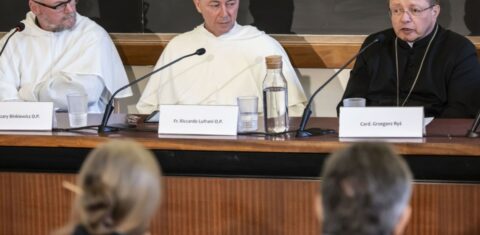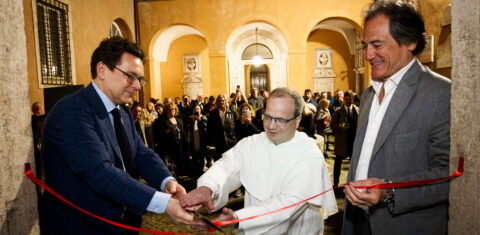In the first session of the seminar, participants talked about different perspectives on beauty and art. Each speaker presented a different representation of the Annunciation from a wide range of painting traditions, treating it as a starting point for theoretical deliberations. The session began with Father Joseph Hudson OSB, a priest from the USA and doctoral student at the Angelicum’s Faculty of Theology. In his talk, starting from a thoroughly modern depiction of the Annunciation by the American artist Michelle Arnold Paine, Father Hudson asked about what constitutes the beauty of a painting. He walked the audience through three ways of looking at beauty, starting with the writings of St. Thomas Aquinas, through the philosophy of David Hume and ending with the thought of Immanuel Kant. Father James Raymond Cortez from the Philippines, a student of the Faculty of Philosophy, presented his own painting of the Annunciation, inspired by the “Let’s Paint Catholicism Again” project, and in his speech presented Cardinal John Henry Newman’s theory of sacred art. The first session was closed by Bogdana Katarzhuk, Ukrainian lawyer and graduate of interreligious dialogue studies at the Angelicum, who discussed The Annunciation by Oleksandr Murashko. She drew attention to the elements of Eastern and Western traditions visible in the painting, pointing to this representation as an example of a meeting of religious symbolism and modernism.
The second session of the seminar was devoted to the lessons that flow from the mystery of the Annunciation and its particular depictions. Valentina Giroldini, an Italian from the Thomistic Institute, in her talk entitled Art as an Itinerary of Faith: the Annunciation, referred to the comments of recent popes on the role of art in the Christian spiritual path. She recalled pope Paul VI’s words from his message to artists delivered in 1965: “The world we live in needs beauty so as not to sink into despair!”, pointing to their particular relevance also today. Analyzing Leonardo da Vinci’s Annunciation, she drew attention to the symbolism of the painting and its invitation to a personal “fiat!” of every believer. Gina Pribaz Vozenilek, an American student of the Institute of Spirituality shared her personal experience from traveling through Sicily and contemplating Antonella da Messina’s painting L’ Annunciata di Palermo. She showed the Annunciation as a call to abandon fear about the future and trust God unconditionally. The final speaker was Tomasz Frycze, last year’s Saint Nicholas Foundation scholarship holder and a graduate of JP2 Studies at the Angelicum. Starting from the painting by Father Jacek Hajnos, OP, he referred to the thoughts of the Polish Pope. In the Gratissimam sane Letter to Families from 1994 saint John Paul II, meditating on the event of the Annunciation, calls Mary “Mother of Beautiful Love”. Mary’s motherhood is a call for us to adopt an attitude of internal dialogue with God, which is a source of Beautiful Love.
The discussion returned to the paintings of the Annunciation created as part of the “Let’s Paint Catholicism Again” project to compare them with classical representations and to consider what constitutes the depth of a sacred image and whether contemporary artists are able to achieve this depth equaly with masters from centuries ago. Questions were also asked about the role that sacred painting plays in the spiritual path of the artist himself, as well as about the possibility and sense of attracting non-believing artists to the Church. Is a non-believing artist able to paint the Truth in a sacred painting? Does the creative process have the power to trigger spiritual transformation? – asked Anna Brojer, a student of the Institute of Spirituality, leading the discussion. Gina Pribaz pointed to the enormous power of spiritual transformation that takes place in an artist when he takes up a sacred topic: “Contemporary artists approach religious topics with reserve, sensing that facing the Truth will change them. They are afraid of that change” she concluded. Reference was also made to the “Church and Culture” conference organized the previous day by the St. John Paul II Institute of Culture at the Angelicum. Participants of the seminar returned to the theme raised by Cardinal Grzegorz Ryś about the fundamental task of the Church, which is entering into dialogue with the contemporary world and, in its relations with artists – listening to them. The Church has always been listening and still listens. She never gave up this task – emphasized Deacon Jason Keith Fernandes, a postdoctoral student representing India. Finally, it was emphasized that the contemporary Church must find space not only for new artistic interpretations of classic sacred themes, but also for a conversation about the role of beauty and dialogue with the artistic community in the Christian understanding of the concept of “dialogue”. Dialogue solely understood as a conversation is not enough, it is necessary to have a dialogue that takes into account the existence of the ‘Logos’, and therefore is conducted with reason and recognizes the role of Truth – concluded Father Joseph Hudson OSB.
The idea of the “Theology, Art & Beauty” student seminar was born in 2023 after the first edition of the “Let’s Paint Catholicism Again” project. Roman students from various pontifical universities meet to talk about their impressions from the painting exhibitions and the role of sacred art and beauty in the Chritian spiritual path. Some of the speeches from this year’s seminar will be published in “La Parola”, the Angelicum student magazine in May.
The next edition of the seminar is planned for the 2024/25 academic year.




